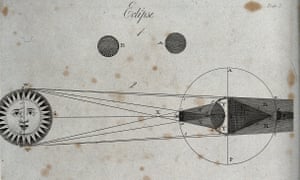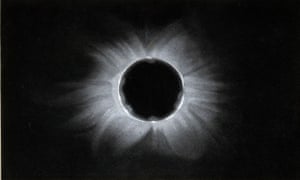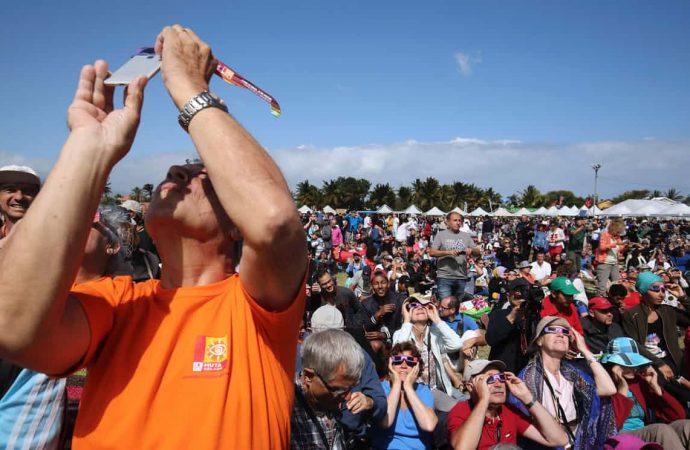A total solar eclipse has always had the power to fascinate humans and affect the actions, purses, thoughts and knowledge of humans all over the world
While not in the ways claimed by astrologers, it can’t be denied that the motions of the heavens sometimes have a strong influence on events on Earth. We can with confidence predict that a full solar eclipse, such as that visible across the USA and online today, will prompt unusual actions from large numbers of people, as well as peculiar animal behaviour and a dip in the generation of solar power, as the sun casts the moon’s shadow over part of the Earth.
The influence of the 2017 solar eclipse has, indeed, been powerful enough to stretch back several years prior to today’s event. Although it is simply the result of a particular and momentary alignment of the sun, Earth and moon, astronomy enthusiasts and science communicators have been preparing for years with newspaper articles, books, talks, exhibitions, events and merchandise.
There is, of course, little new in this. Humans have, we might assume, always been fascinated by the effect of a total solar eclipse. Before they were predictable, such events might cause excitement, bemusement or fear while they were in progress. As soon as they could be predicted, however, they have prompted even greater anticipation, discussion, preparation, travel – and, yes, sometimes, fear.
We like to contrast our enlightened selves with the ignorant and superstitious other, whether of the past or present. It was, for example, a common trope for Western imperial nations in the 19th century to compare the calm preparations of their astronomers on eclipse expeditions with the expected wonder or fear of native populations. Today we still worry about people foolishly looking directly at the sun, charlatans selling shoddy eclipse glasses and the impact on local health services of a sudden influx of eclipse chasers to small towns.
There are also those who claim less direct impacts, drawing on the long tradition of eclipses as signs and portents. Just as the astrologer William Lilly claimed that the solar eclipse of 11 August 1645 signalled the end of the House of Stuart, in 2017 Newsweek reported that some astrologers believe the eclipse indicates “some kind of downfall, some kind of ruin, some kind of difficulty” for Trump personally, or the US more generally.
However, without needing to go near the claims of astrology, history shows us that solar eclipses have had their impact on the actions, purses, thoughts and knowledge of humans all over the world.
Eclipse-watching through the centuries Pre-modern
Several ancient cultures independently attempted to understand and predict solar eclipses, noting patterns over long periods of time. The earliest records are Chinese, dating from 2137BCE. It was the Greeks who established that solar eclipses are caused by the moon’s shadow, and thus that accurate predictions require us to understand the complex motions of the lunar cycle. Over centuries people were motivated to unpick this challenging astronomical puzzle for political, economic, religious and astrological reasons.
By at least the 15th century, astronomical tables, though based on a geocentrical model, were good enough to predict the date of an eclipse. It was much more difficult to forecast the path of the shadow, meaning that eclipse observations were largely a matter of chance. If you happened to be in the right place at the right time you could experience the event, and a few left reports of a corona or even solar prominences, but it was impossible to know in advance if you would experience totality, or to travel to a place where you could.

17th and 18th centuries
There were huge jumps in the accuracy of lunar theory and mapping of the Earth in the 17th and 18th centuries, as both practical observation and astronomical theory improved. It became possible to predict the geographical locations at which totality might be observed and in 1705 two maps were published in advance of the eclipse of 1706. Visible across large parts of Continental Europe, this was widely observed, including perhaps the first telescopic observation.
Britain’s opportunity came in 1715, with a map produced by Edmond Halley that showed a predicated path differing only about 20 miles from the actual one. As I have written previously, this was something of a coup for the predictive power of Newtonian physics. Halley aimed his map at a broad readership of “the Curious”, advertising the successes of the new astronomy, encouraging observations to improve future predictions and emphasising the natural rather than ominous nature of the event.
There were many further 18th-century eclipse maps and, undoubtedly, a number of the most motivated (if they had time and money) travelled to ensure they experienced totality. In their book Celestial Shadows, John Westfall and William Sheehan suggest that the first official eclipse expedition took place when a party from Harvard travelled to Maine in October 1780. It was the more remarkable that this took them behind enemy (British) lines during the Revolutionary War but, sadly, an error in longitude meant that they missed totality.
19th and 20th centuries
Travel remained restricted during the French Revolutionary and Napoleonic Wars but was increasingly possible in the 19th century, as steam ship and tourist routes opened up. This coincided with a lack of solar eclipses taking place over Europe and North America, leading to a great boom in eclipse expeditions, organised by national observatories, universities and astronomical societies.
By the later 19th century eclipses might be, as historian Alex Soojung-Kim Pang described, “the social event of the season”. Taking advantage of accessible travel routes, tourist infrastructure, colonial settlement and military presence across the European empires, a significant number of professional and amateur astronomers, including women, travelled to view eclipses.
Developments in observation techniques, including the arrival of photography and spectroscopy, meant that the structure and nature of the sun’s corona could begin to be studied in detail, and linked to what was known of its surface, composition, cycles and magnetic influence on Earth. In 1919 an eclipse famously gave the opportunity to make measurements to test one of the predictions of Einstein’s theory of relativity.

Such expeditions were only for a few but they were well covered for readers back home by popular science publications and general magazines. These articles typically told of scientific success and heroic endeavour with an imperial backdrop. Elsewhere, eclipses have long featured in caricatures as political metaphor, but seem not to have prompted celebration in jewellery or song as did comets and transits of Venus in the 19th century.
Today
In the late 20th and 21st centuries there is still science to be done, and enthusiasts have continued to travel, but eclipses have become an increasingly important opportunity for science broadcasters, museums and writers aiming to reach a wide public.
The 1999 eclipse over Europe, the first total solar eclipse visible on the British mainland since 1927, was recorded as the most widely observed eclipse in history. It prompted large amounts of television coverage, merchandise and public interest. The 2017 total solar eclipse, the first visible across a substantial part of the US for 99 years, looks set to (forgive the inevitable pun) eclipse this.
Source: The Guardian

































Leave a Comment
You must be logged in to post a comment.